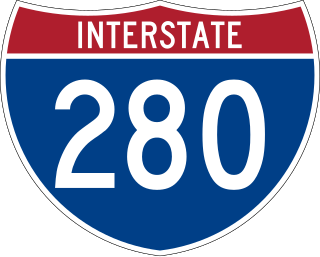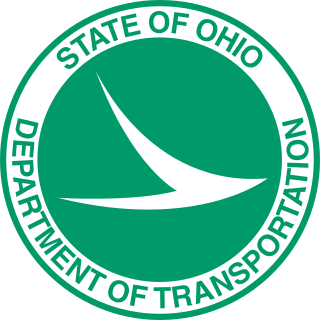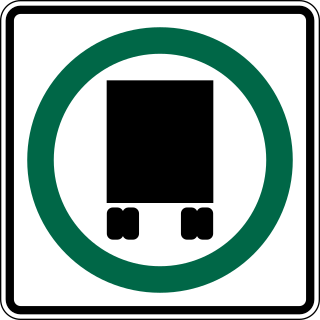
The Surface Transportation and Uniform Relocation Assistance Act of 1987 is a United States Act of Congress, containing in Title I, the Federal-Aid Highway Act of 1987.

An intelligent transportation system (ITS) is an advanced application which aims to provide innovative services relating to different modes of transport and traffic management and enable users to be better informed and make safer, more coordinated, and 'smarter' use of transport networks.

An advanced driver-assistance system (ADAS) includes technologies that assist drivers with the safe operation of a vehicle. Through a human-machine interface, ADAS increases car and road safety. ADAS uses automated technology, such as sensors and cameras, to detect nearby obstacles or driver errors, and respond accordingly. ADAS can enable various levels of autonomous driving.

Interstate 280 (I-280) is an auxiliary Interstate Highway that makes up the western and southern portions of the beltway around the Quad Cities of Illinois and Iowa. The freeway starts at I-80 near Davenport, Iowa, and ends at I-80 near Colona, Illinois; its eastern part runs concurrent with I-74 to return to I-80. I-280 forms the southern part of a circle around the Quad Cities as well as forming part of a bypass for US Route 61 (US 61) around Davenport. This road is 26.98 miles (43.42 km) long.

The United States federal Transportation Equity Act for the 21st Century (TEA-21) is a federal transportation bill enacted June 9, 1998, as Pub. L.Tooltip Public Law 105–178 (text)(PDF) and 112 Stat. 107. TEA-21 authorized federal surface transportation programs for highways, highway safety, and transit for a 6-year period from 1998 to 2003. Because Congress could not agree on funding levels, the Act, which had continued past 2003 by means of temporary extensions, was allowed to lapse.

The Intermodal Surface Transportation Efficiency Act of 1991 is a United States federal law that posed a major change to transportation planning and policy, as the first U.S. federal legislation on the subject in the post-Interstate Highway System era.

A metropolitan planning organization (MPO) is a federally mandated and federally funded transportation policy-making organization in the United States that is made up of representatives from local government and governmental transportation authorities. They were created to ensure regional cooperation in transportation planning. MPOs were introduced by the Federal-Aid Highway Act of 1962, which required the formation of an MPO for any urbanized area (UZA) with a population greater than 50,000. Federal funding for transportation projects and programs are channeled through this planning process. Congress created MPOs in order to ensure that existing and future expenditures of governmental funds for transportation projects and programs are based on a continuing, cooperative, and comprehensive ("3-C") planning process. Statewide and metropolitan transportation planning processes are governed by federal law. Transparency through public access to participation in the planning process and electronic publication of plans now is required by federal law. As of 2015, there are 408 MPOs in the United States.
The Research and Innovative Technology Administration (RITA) is a unit of the United States Department of Transportation (USDOT). It was created in 2005 to advance transportation science, technology, and analysis, as well as improve the coordination of transportation research within the department and throughout the transportation community.

The National Highway System (NHS) is a network of strategic highways within the United States, including the Interstate Highway System and other roads serving major airports, ports, military bases, rail or truck terminals, railway stations, pipeline terminals and other strategic transport facilities. Altogether, it constitutes the largest highway system in the world.
The Integrated Transport Information System (ITIS) is a traffic management system in Klang Valley, Malaysia. The system began operation on 2005 with the cooperation of Kuala Lumpur City Hall (DBKL), Malaysian Highway Authority, Malaysian Public Works Department (JKR) and the Ministry of Transport Malaysia. The system is used for traffic monitoring, accident, construction and other situations that happen on the roads and highways in Kuala Lumpur and Klang Valley. The main ITIS headquarters and traffic operation centre is located at Bukit Jalil Highway near Technology Park Malaysia in Bukit Jalil.

The Ohio Department of Transportation is the administrative department of the Ohio state government responsible for developing and maintaining all state and U.S. roadways outside of municipalities and all Interstates except the Ohio Turnpike. In addition to highways, the department also helps develop public transportation and public aviation programs. ODOT is headquartered in Columbus, Ohio. Formerly, under the direction of Michael Massa, ODOT initiated a series of interstate-based Travel Information Centers, which were later transferred to local sectors. The Director of Transportation is part of the Governor's Cabinet.

Active traffic management is a method of increasing peak capacity and smoothing traffic flows on busy major highways. Techniques include variable speed limits, hard-shoulder running and ramp-metering controlled by overhead variable message signs. It has been implemented in several countries, including Germany, the United Kingdom, Canada and the United States.
COMPASS, also referred to as Freeway Traffic Management System, is a system run by the Ministry of Transportation of Ontario (MTO) to monitor and manage the flow of traffic on various roads in Ontario.

The National Network is a network of approved state highways and interstates for commercial truck drivers in the United States. The Surface Transportation Assistance Act of 1982 authorized the establishment of a national network of highways designated for use by large trucks. On these highways, Federal width and length limits apply. The National Network (NN) includes almost all of the Interstate Highway System and other, specified non-Interstate highways. The network comprises more than 200,000 miles (320,000 km) of highways.

International Road Dynamics Inc. is a road traffic management system engineering company headquartered in Saskatoon, Saskatchewan, Canada. Its services include automated toll roads, commercial vehicle inspection systems, traffic data collection products, and traffic management software.

IRIS is an open-source Advanced Traffic Management System (ATMS) software project developed by the Minnesota Department of Transportation. It is used by transportation agencies to monitor and manage interstate and highway traffic. IRIS uses the GPL license.
PTV GmbH is a German company specializing in software and consulting services for traffic and transportation and mobility. Their transport planning software, Vision Traffic Suite comprise the PTV Group's product portfolio. According to the manufacturer; over 2,500 customers in more than 120 countries use the Vision Traffic Suite in the fields of transport modelling and traffic flow calculation. PTV ranks among the top 1,000 global market leaders in Germany according to Germany's Manager Magazine.
The Intelligent Transportation Systems (ITS) Institute is a national University Transportation Center headquartered at the University of Minnesota. The ITS Institute researches activities to enhance the safety and mobility of road-based and transit-based transportation, particularly in a northern climate and in rural environments. The ITS Institute focuses on human-centered technology, such as computing, sensing, communications, and control systems.
Urban freight distribution is the system and process by which goods are collected, transported, and distributed within urban environments. The urban freight system can include seaports, airports, manufacturing facilities, and warehouse/distribution centers that are connected by a network of railroads, rail yards, pipelines, highways, and roadways that enable goods to get to their destinations.

Thomas D. Larson was an American administrator, who was sworn in as the Federal Highway Administrator on August 10, 1989. A native of Pennsylvania, Larson came to the FHWA after a career as a researcher, Professor of Civil Engineering, and administrator at the Pennsylvania State University. He was Pennsylvania's Secretary of Transportation for eight years, and a leader in the American Association of State Highway and Transportation Officials and the Transportation Research Board.











